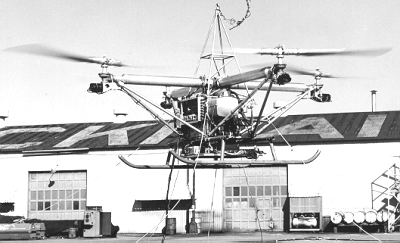PA-4 Sea-Bat

The PA-4 "Sea-Bat" was an early quad-rotor unmanned air vehicle developed for shipboard use and weapons delivery by the Piasecki Aircraft Corporation (PiAC). The drone's control system and rotor were configured to allow the aircraft's center body to keep a constant azimuth heading regardless of the UAV's direction of travel. Two pairs of tilting 12 foot propellers with dual differential collective control allowed the aircraft to be omni-directional. A vertical gyroscope sent signals to the differential pitch of each pair of rotors to maintain a constant heading. The two pairs of rotors each turned in an opposite direction, but were balanced in torque in all positions by differential tilt angle. The UAV used a vertical shaft 6 cylinder Lycoming VO435 engine and electronic controls were made by PiAC, with a purported endurance of two hours.
On October 25, 1958, Sea-Bat testing successfully flew a tethered flight at Piasecki Morton Factory Heliport, Morton, PA, demonstrating the ability to hover and maintain a level attitude. Sea-Bat was damaged in an accident while maneuvering to avoid hitting an unauthorized person in the test area, however the system demonstrated the viability of a quad-rotor design for vertical flight. Subsequent variants, including the "Mud-Bat" and "Ice-Bat", were designed to meet other mission requirements.